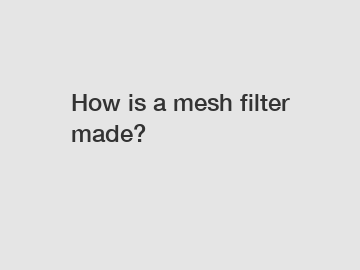How is a mesh filter made?
"How is a Mesh Filter Made?".
Mesh filters are widely used in various industries to separate solids from liquids or gases. These filters are composed of a mesh material that allows the passage of certain particles while filtering out others. But have you ever wondered how these filters are made? In this article, we will explore the process of manufacturing a mesh filter, from selecting the material to the final product.
Selecting the Material.

The first step in making a mesh filter is selecting the appropriate material. Mesh filters can be made from a variety of materials such as stainless steel, copper, aluminum, or synthetic fibers. The choice of material depends on the specific application and the desired properties of the filter. For example, stainless steel is commonly used for its corrosion resistance and durability.
Wire Drawing.
Once the material is selected, the next step is wire drawing. Wire drawing is the process of reducing the diameter of the wire while elongating it at the same time. This is achieved by pulling the wire through a series of dies, each with a smaller diameter, until the desired thickness is achieved. Wire drawing helps in improving the wire's strength, surface finish, and dimensional accuracy.
Weaving the Mesh.
After wire drawing, the wire is ready to be woven into a mesh. Weaving is a process that interlaces multiple wires in a crisscross pattern to form a grid-like structure. There are different weaving techniques used, such as plain weave, twill weave, or Dutch weave, each with its own characteristics. The weaving process can be done manually or using automated machines depending on the complexity of the mesh design.
Heat Treatment and Surface Finishing.
Once the mesh is woven, it undergoes heat treatment to improve its strength and stability. Heat treatment involves exposing the mesh to high temperatures for a specific period. This process helps in relieving the stresses formed during weaving, making the mesh more resilient. After heat treatment, the mesh may go through surface finishing processes like electropolishing or coating to enhance its appearance and performance.
Cutting and Shaping.
Once the mesh is ready, it is cut into the desired shape and size. The cutting process can be carried out using various techniques such as laser cutting, water jet cutting, or manual cutting, depending on the precision required. The shaped mesh is then carefully inspected for any defects or irregularities before proceeding to the final steps.
Quality Control and Packaging.
Quality control is a crucial step in the manufacturing of mesh filters. The filters undergo rigorous testing to ensure that they meet the required specifications and standards. Common tests include checking for the correct mesh count, aperture size, and uniformity of the mesh. Once the filters pass the inspection, they are packaged for shipment to the end-users.
Conclusion.
In conclusion, the production of a mesh filter involves selecting the appropriate material, wire drawing, weaving, heat treatment, cutting, quality control, and packaging. Manufacturers carefully follow each step to ensure that the final product meets the required specifications. Mesh filters play a vital role in various industries, offering efficient and reliable filtration solutions.
If you have any further questions or would like to learn more about the manufacturing process of mesh filters, please do not hesitate to contact us. We are here to assist you with all your filtration needs.
For more information, please visit plain weave stainless steel wire price, China Epoxy Coated Wire Mesh, Epoxy Mesh for industry.
174
0
0

Comments
All Comments (0)